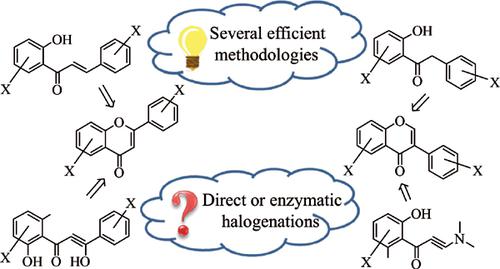Current Organic Synthesis ( IF 1.7 ) Pub Date : 2020-08-31 , DOI: 10.2174/1570179417666200530213737 Ricardo Santos 1 , Diana Pinto 1 , Clara Magalhães 2 , Artur Silva 1

|
Background: Flavonoid is a family of compounds present in the everyday consumption plants and fruits, contributing to a balanced diet and beneficial health effects. Being a scaffold for new drugs and presenting a wide range of applicability in the treatment of illnesses give them also an impact in medicine. Among the several types of flavonoids, flavone and isoflavone derivatives can be highlighted due to their prevalence in nature and biological activities already established. The standard synthetic route to obtain both halogenated flavones and isoflavones is through the use of already halogenated starting materials. Halogenation of the flavone and isoflavone core is less common because it is more complicated and involves some selectivity issues.
Objective: Considering the importance of these flavonoids, we aim to present the main and more recent synthetic approaches towards their halogenation.
Methods: The most prominent methodologies for the synthesis of halogenated flavones and isoflavones were reviewed. A careful survey of the reported data, using mainly the Scopus database and halogenation, flavones and isoflavones as keywords, was conducted.
Results: Herein, a review is provided on the latest and more efficient halogenation protocols of flavones and isoflavones. Selective halogenation and the greener methodologies, including enzymatic and microbial halogenations, were reported. Nevertheless, some interesting protocols that allowed the synthesis of halogenated flavone and isoflavone derivatives in specific positions using halogenated reagents are also summarized.
Conclusion: Halogenated flavones and isoflavones have risen as noticeable structures; however, most of the time, the synthetic procedures involve toxic reagents and harsh reaction conditions. Therefore, the development of new synthetic routes with low environmental impact is desirable.
中文翻译:

卤代黄酮和异黄酮:其合成的最新技术。
背景:类黄酮是日常食用植物和水果中存在的一类化合物,有助于均衡饮食和有益健康。作为新药的支架,并且在疾病治疗中具有广泛的适用性,这也使它们对医学产生了影响。在几种类型的类黄酮中,黄酮和异黄酮衍生物因其在自然界的盛行和已经建立的生物活性而得以突出。获得卤代黄酮和异黄酮的标准合成途径是使用已经卤化的原料。黄酮和异黄酮核心的卤化较不常见,因为它更复杂并且涉及一些选择性问题。
目的:考虑到这些类黄酮的重要性,我们旨在介绍主要的和最新的卤代合成方法。
方法:综述了卤代黄酮和异黄酮合成的最主要方法。对报告的数据进行了仔细的调查,主要使用Scopus数据库,并以卤化,黄酮和异黄酮为关键字。
结果:本文对黄酮和异黄酮的最新,更有效的卤化方案进行了综述。报道了选择性卤化和更绿色的方法,包括酶促卤化和微生物卤化。然而,总结了一些有趣的方案,这些方案允许使用卤化试剂在特定位置合成卤化黄酮和异黄酮衍生物。
结论:卤代黄酮和异黄酮已经以明显的结构上升。然而,大多数时候,合成过程涉及有毒试剂和苛刻的反应条件。因此,需要开发对环境影响小的新的合成路线。











































 京公网安备 11010802027423号
京公网安备 11010802027423号